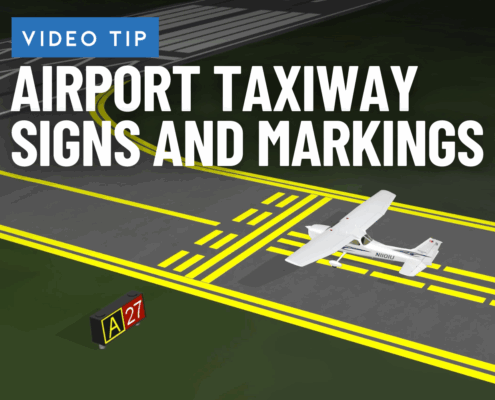
Taxi With Confidence: Airport Taxiway Signs and Markings for Pilots
/
4 Comments
All airports with ATC control towers in the U.S. (and some non-towered airports) use a standard set of pavement markings and elevated signs to guide pilots from the parking airport to the active runway. In this video, we'll explore the location and meaning of each in a simulated 3D airport environment so that you'll be well prepared on what to expect when taxiing at a large airport.

Video Tip: VFR communications
Talking on the radio can be intimidating for new pilots, but with a few tips in mind it doesn't have to be hard. In our latest video tip, we give you a few basics to remember so you can sound like a pro when you talk to tower or on the CTAF. If you know what to expect, you'll be a lot more confident.

Video tip: How to determine the wind direction for takeoff and landing
When departing or approaching an airport, it's important that you choose a runway that allows you to takeoff or land into the wind. This week's tip looks at some common wind direction indicators found on the ground at many airports, along with how to use the radio to tune into automated weather reporting systems.

FAA Pilot Minute Video: Will Prescribed Testosterone Affect My Medical?
The FAA’s Office of Aerospace Medicine has released a “Pilot Minute” video that addresses the growing use of testosterone therapy and how it can affect your medical certification. Whether you're currently taking testosterone or considering it, it's important to understand the potential impact on your eligibility to fly. In this short video, Federal Air Surgeon Dr. Susan Northrup explains what the FAA looks for and how to stay in compliance.

Video tip: the Cessna 172 fuel system
It's important for pilots to have a good understanding of airplane systems to know how to properly operate their controls and troubleshoot them when things don't work as expected. This week's tip takes a look at the Cessna 172 fuel system to show each component and give you a better understanding of how all the parts work together.

Video tip: How to takeoff and land from a short runway
An advanced skill you’ll learn during flight training is how to achieve the maximum performance from the airplane by operating from shorter runways.

VASI & PAPI Explained: Pilot’s Guide to Visual Approach Lighting
Visual approach slope indicators use a combination of white and red lights next to the runway to help pilots verify they are flying the correct approach angle to the runway. This week's video takes a closer look at 2 types, VASI and PAPI, to show you how they work and what the various indications mean.

Interactive video tip: Flying with a constant-speed propeller
Airplanes with a high-performance engine typically contain a constant-speed propeller for greater efficiency. Learn all about their operation with our latest tip, including how to properly use the throttle, prop control, manifold pressure gauge and tachometer in each phase of flight.

Video tip: how to spot traffic in-flight
Collision avoidance skills are emphasized early on in the flight training process, and it's important that you make an effort to keep your eyes out the window as much as possible when practicing maneuvers. This week's video takes a look at a few tips you can incorporate on your next flight to help spot nearby traffic, along with some new technology innovations that allow you to display nearby traffic right on your favorite aviation iPad app.

How to take off and land in a multiengine airplane
Earning a multiengine rating can open up a world of adventure, from reliable cross country travel to new career options. Our latest video tip includes a segment from Sporty's new Multiengine Training Course, to give you a feel for the steps to safely operate a multiengine airplane on a normal VFR flight, from startup to landing.
